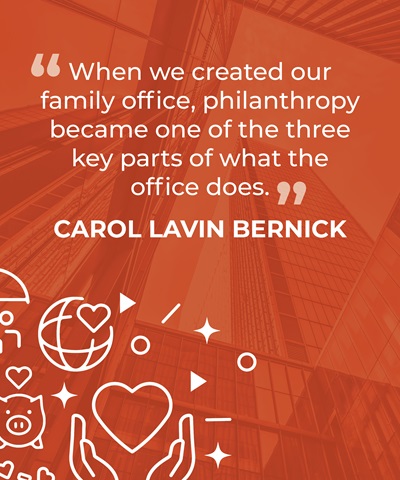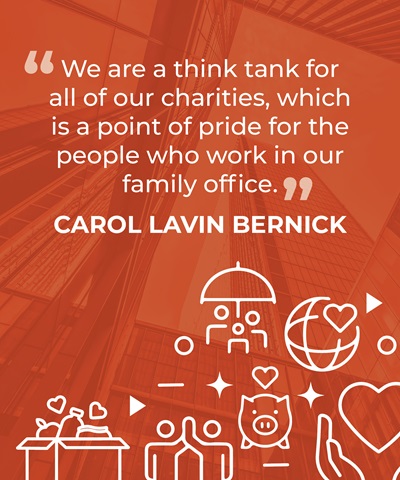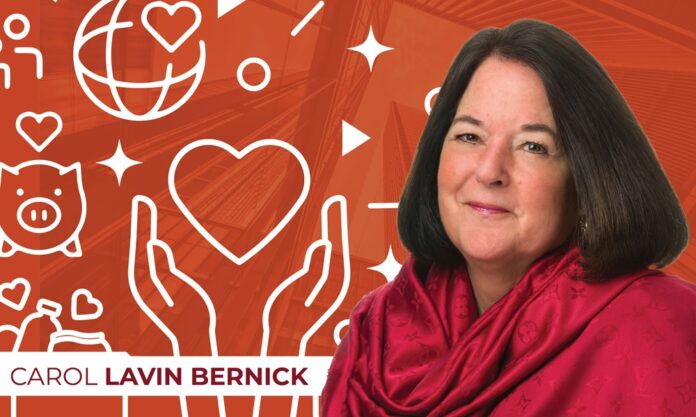Carol Lavin Bernick worked for 37 years for the Alberto Culver Company, which her parents founded. She led its consumer goods business and succeeded her father as executive chairman of the board. In 2011, she negotiated the sale of the company to Unilever. She discusses the nonprofits she and her family have formed since the sale, as well as the relationship between the Lavin Family Foundation, the family’s other foundations and the family business office, Polished Nickel Capital Management:
What is your philosophy of philanthropy?
I believe you change what you measure. I ask four questions about any venture:
- What are you trying to do?
- How much will it cost?
- How will you measure success?
- And when will it be done?
You need to know what outcome you want from your philanthropy. Most of our philanthropy is directed to a specific outcome.
For example, my son-in-law grew up on the South Side of Chicago. At the beginning of COVID, he had a friend over whose family restaurant had to fire 40 employees. I said to him, ‘I’ll support you sending pizzas to charities for the next three months.’ We eventually called it Feed It Forward, and our purpose was to keep small family restaurants alive during COVID by feeding people in need. We put $3.5 million into the community, saved 150 restaurants, and served over 75 charities during that time. That was completely executed out of our family office.
How did you develop your current philanthropic strategy?
When we ran the Alberto Culver Company, the company gave many millions of dollars to the nonprofit community, and so did my family’s foundations. When we sold the company, all those charities that we had given money to — in Chicago and other cities where we had plants — hoped that our family would continue to give in equal amounts. That would have exhausted our foundation in 10 years. We were looking for a way to make as big of an impact with less money.
We created three charities: Enchanted Backpack, CC’s Wish List and the CAST Water Safety Foundation. They are supported by the family foundation with 100% of administrative costs, warehouses and personnel costs being covered by us. When people donate to the three charities we created, 100% of their donations go directly to the goods and services that the charities provide.
How are your charities, your family foundations and your family office related?
When we created our family office, philanthropy became one of the three key parts of what the office does.
We have several foundations. I have my own Carol Lavin Bernick Family Foundation, and we also have the Lavin Family Foundation. We also have a couple of supporting foundations. All of the investing and regulatory compliance for the family’s foundations is done through the family office, though they are separate entities.

The family office is also the accounting department and the legal department for our charities. One of my financial managers is a co-director of one of our charities. All the people serving our charities are hired by the family office.
Finally, we are a think tank for all of our charities, which is a point of pride for the people who work in our family office. I’m a big believer in helping others as being something to pump up your workforce. In our family office, we also give everybody who works for us $5,000 a year to donate to charities of their choice.
What charities have you founded, and how did they come about?
We used to spread our money in many different places. Now, approximately half of our annual budget goes to support the nonprofits we created, which support communities in huge ways and, in fact, quadruple the impact of our dollars.
My daughter was a teacher in Title I schools, and one of the most fun things I ever got to do was help set up her classroom. We came up with this idea of Enchanted Backpack, whose brightly colored vans are filled with school supplies. We go to 50 schools a year and provide in-kind donations of brand-new school supplies, books, art and athletic equipment, winter coats and more — a $40,000 donation to each school at retail.
We buy these things for about $10,000. From early in my career at Alberto, I knew how major companies sold closeout merchandise. There are shows where you can buy high-quality children’s coats for $8 or $9, or T-shirts for 65 cents. So, I find a $1 million source of goods, which is the equivalent of $4 million a year of items for these under-resourced schools.
We were becoming known at these closeout shows, and people started coming to us with sheets, blankets, pillows, men’s coats and suits, and more. I said, ‘This is too good to pass up,’ so we started CC’s Wish List. It provides between 100 and 150 nonprofits every year across Chicagoland and Florida with tens of thousands of cases of soft goods that they can distribute.

My biggest joy comes from helping the helpers. Can you imagine being a nurse and sending somebody out into a Chicago winter without a coat, or seeing a child with shoes where the toe areas were cut off at the top because their shoes are too small? We can put goods that are requested into the hands of vetted nonprofits, and do it at quarters on the dollar.
Our third nonprofit came about because we had a friend of a friend’s child die in a drowning accident. The leading cause of death in children under the age of 4 is drowning. We felt a call to act. And then we learned how difficult it was to get pools and instructors to teach self-rescue swimming lessons to little kids. So, we started the CAST Water Safety Foundation, which my daughter runs. The foundation gives scholarships to teach children ages 1-5 lessons and train more instructors. They also are doing national research to prove the validity of self-rescue swim skills for children ages 1 through 4 and raise the prominence of the issue in the medical community.
Have these charities evolved since their founding?
My family has always been entrepreneurial. It’s a real kick to be able to make it happen and have it be successful. Our family’s motto is ‘Innovative Philanthropy at Work.’
We do surveys to build these nonprofit programs. With Enchanted Backpack, we started out with the school supplies. Since we founded it in 2018, we have added Teacher Appreciation, Washer & Dryer, Pay It Forward and Adopt-a-School programs.

So now we put at least 15 washers and dryers in Chicago schools every year, because when you have clean clothes, you have better attendance. We’ve added a teacher appreciation program because nobody has money to appreciate their teachers, and when the teachers feel better, the kids benefit. We buy a blanket, or a purse, or a set of gloves or a journal, and we give them to the principals. The principals sign a pledge to us that they will make them a big part of appreciation for their teachers. It’s people touching people — it’s the kindness factor.



